
| Home
| Newbies Guide | Technical Resources
| Lada Niva Clubs | Niva
Lift Kits | Gallery | Links
|

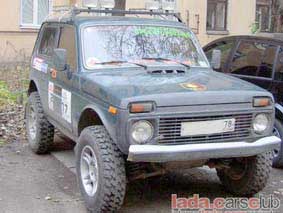
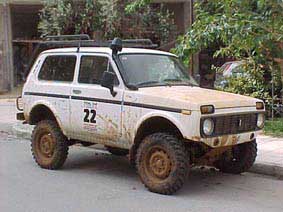
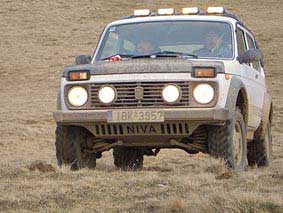
The Lada Niva is relatively easy to lift, and while you can get Niva lift kits off-the-shelf nowadays, Niva lifts can also be easily done a number of Do-It-Yourself ways.
Below are details for the four main Niva lift methods, but bear in mind this amusingly translated piece of Russian advice on lifting Nivas — "free cheese it does not occur, any elevator kills suspension"; ie lifting will lead to some compromises. Suspension and drive-train parts will wear out quicker because there is greater stresses on them, and any vehicle that is lifted will not handle on the road as well as before because you've increased the centre of gravity, also in the case of the Niva you may introduce bump-steer. And don't forget to check out the specific warnings at the bottom of the page.
Note: For those from sensible metric countries 1 inch or 1" equals about 25mm (25.4 to be more exact), so a 2" lift is refered to as a 50mm lift..
Also note: I can't vouch for any of the suppliers listed below as I have not dealt with them personally (but I welcome your feedback about any Niva parts suppliers).
![]() Click on images for a larger view.
Click on images for a larger view.
<< Back to Baxter's Temple of Niva main page
There are 4 main ways to lift a Niva's front suspension, all of which lift the cross-member and diff from the ground: coils, rings, wedges, or tubes. Longer coils or spacer-rings essentially increase the length between the upper and lower wishbones. Wedges and tubes also increase this length, but by lifting the coil-platform from the wishbone.

Four methods for lifting the Lada Niva's front suspension
(click on image for
a bigger view)
Front lifts can generally keep the standard dampers (see below), but ideally need either the upper bump-stop to be trimmed or a ball-joint spacer (details below) to be fitted.
After any front suspension lift you'll need to get your steering alignment reset as it will create toe-out and increased positive camber (some people have found they need ball-joint spacers to keep the camber within adjustment range).
If you do not remove your anti-sway bar there are complications for lifts that raise the coil platform (eg wedges, and tubes) - please note the warnings (and solutions) at the bottom of the page regarding modifications that lift the coil platform while retaining the anti-roll bar.
Detailed information on these lifts is below.
You can of course also get an inch or so lift simply from fitting taller tyres. This has the advantage of also raising your differentials' height from the ground.
Most Niva rear end lifts are done with either spacer-rings or longer coils. Lifting the rear will not raise the diff centre from the ground; only taller tyres will do that. Rear lifts generally require longer travel dampers to be fitted (more details below).
Check the rear brake hose isn't under stress at full suspension travel, as some people have needed to also fit a longer rear brake hose with rear lifts. With the Hoodoo 50mm lift I haven't found this necessary if 'short' standard dampers are retained, but it has become necessary when I fitted longer dampers.
You may also need to adjust your brake proportioning valve, or extend its bracket (see below).
Detailed information about lifting the rear is below under Lifting the Rear.
Please note the warnings at the bottom of the page.
If
you're in doubt about anything check in at Lada.co.uk
![]() or with any of the
better Niva Facebook groups for advice - as suspension failure can be fatal.
or with any of the
better Niva Facebook groups for advice - as suspension failure can be fatal.
Important note
With any front lift which raises the platform which the coil sits on (ie wedge, plate, tube, or washer lifts) there is a risk the anti-roll bar can catch the steering knuckle on full right hand steering lock. This is obviously extremely dangerous.
The common solution is simply to remove the anti-roll bar (as many people do anyway to increase off-road articulation), and problem solved.
However, if you need to retain the anti-roll bar you must make sure the steering arms can not ever touch on the anti-rollbar anywhere on the steering's travel from lock to lock throughout top to bottom suspension travel and on articulation.
Hoodoo's solution is to essentially relocate the anti-roll bar's mounts on the underside of the coil platform and grinding some off the coil-platform if necessary, here's the instructions from ExCossack's site:
Unfortunately most of the images that go with the above instructions have been lost, but here's the one image I do have and a Russian version of the same thing:
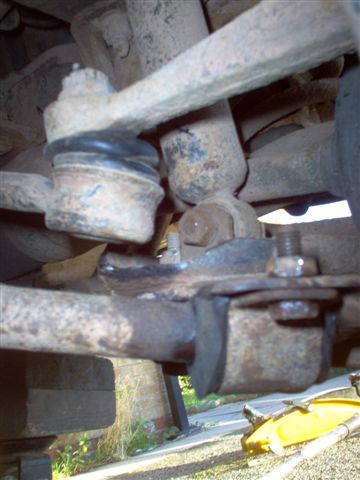
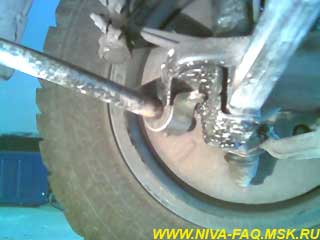
Anti-roll bar - Steering interference fixes
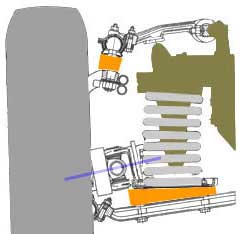 Wedge Lifts
Wedge Lifts The wedge increases the distance between the upper and lower wishbones by raising the coil's lower platform.
The tried & tested do-it-yourself Hoodoo 50mm (2 inch) Lift consists of a short and a long wedge between the lower wishbone and coil-platform, and spacer rings between the rear coils and floor. You can optionally either fit a ball-joint spacer, or trim the top bump-stops 50mm and about 3mm of spacers on the top wishbone to correct the camber.
The advantages of this lift is that it retains the stock spring (and damper rates at the front), and the wedge helps straighten out the banana-ing of the front coils. Also, it is cheap and relatively easy DIY. But if you retain your anti-roll bar be aware of the potential problem (see "Important note" above).
It will give 12.5" under the cross-member on 215/15 tyres, and 13" on 600/16, which is more than enough. There's room to space the front diff down by 0.25" to reduce the drive-shaft angle, spacing it down any lower than this will negate the lift by putting the alloy diff in the firing line for rocks etc.
Though the wedges are made from 3mm box-section steel and look like they might crush or twist easily as they get pounded about off-road, many kits have been built and heavily used - and no breakages have been reported. You could of course have the wedge made from solid steel or alloy.
Hoodoo's rear spacer ring is made from polybush (Internal diameter 86mm, Outer diameter 136mm, Wall width 25mm, Wall height 25mm), see details below. 50mm longer travel dampers are recommended for the rear.
Download the zip file of Hoodoo Lada Niva Suspension Lift Mod MK1 (John Pugh, UK).
View the Hoodoo Fitting Instructions (Jonno).
Hoodoo
![]() has sadly passed
away, but his posts about lifts and various other Niva mods can be searched
at Lada.co.uk
has sadly passed
away, but his posts about lifts and various other Niva mods can be searched
at Lada.co.uk ![]() .
.
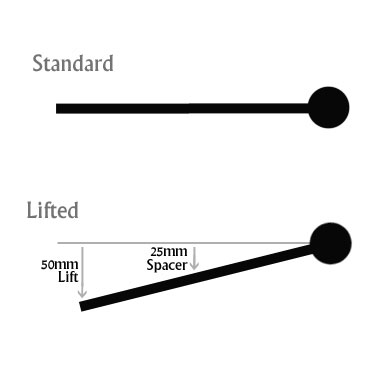
Why a 25mm spacer lifts the body 50mm
Plate
Lift
A variation on the Wedge Lift is the Plate Lift. This would have the advantage
of being more rigid than a wedge, and in someways having a greater seating area
for the coil platform than tube lifts. Dimensions given are: outer plate
24mm, inner plate 16mm. I'd watch out not to make the size difference too
great though (ie the flat base of the coil platform will not like being
stepped too much like I suspect the black ones below will), which mean
it won't be as good a solution for the coil banana-ing as a wedge would be (unless
wedge shaped plates are made). And at 24mm the anti-roll bar warning also
still applies.
But if you retain your anti-roll bar be aware of the potential problem (see "Important note" above).
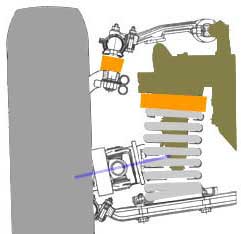 Ring Lifts
Ring Lifts Spacer-ring lifts artificially increase the length of the coil, but they have the advantage of retaining standard coil rates (and standard dampers in the front). This is by far the easiest way of lifting the rear (see the Hoodoo lift above), but can also be used at the front. Like a coil lift they do not lift the coil platform, so they also avoid the steering anti-roll bar conflict.
They are popular in Europe and Niva ones can often be found on Ebay and various Niva after-market dealers.
There are 2 types, either a basic ring that sits between the factory ring and the body, or a taller ring that replaces the factory ring. Suitable generic rings may be bought from 4x4 shops. The front rings need some way of locating the the coil (either a lip, or separate tube).
See below (under Lifting the Rear) for more info on lifting the rear with rings.
For those of us who live where authorities frown on the Hoodoo wedge lift, Hoodoo came up with the Hoodoo2 which uses rings in the front as well as the rear. Here's some pictures of fitting the Hoodoo2 prototype kit that was tested on my Niva.
With 20mm thick ball-joint spacers, my Hoodoo2 lift was about 1.25 to 1.5 inches in the front. On my 205/80-16s the cross-member was originally 10" from the ground, with the prototype Hoodoo2 it was somewhere around 11.25 to 11.5", so you could probably safely use slightly thicker rings to get another 0.5" of lift (as a guide, front rings in the Euro kits look to be about 30 to 40mm thick).
It's pretty much as easy as doing the rear, but you'll also need to make a "BN tube" inner locator ring from a piece of steel tube (80mm ID, 3 to 4mm wall thickness, 60mm tall) to guide the coil into place.
Hoodoo's front spacer ring is: Outer diameter 113mm, Wall height 25mm, Internal diameter is half a mm smaller than the Outer diameter of the BN tube. I'd recommend still using a ball-joint-spacer instead of trimming the bump-stops.
The latest Hoodoo2
DIY information should be at Excossack's
site ![]()
on the "Downloads" page, fitting instructions here
![]() .
.
Also very similar
to the Hoodoo2 kit, though rings are 40 to 45mm thick, the ball-joint
spacer is 30mm thick. The front rings are machined with an inner locator
ring to guide the coils into place. More
info ![]() (Dutch). I assume longer dampers are required on the rear at least. Ladanivabelgium
can be contacted on the US
Lada forum
(Dutch). I assume longer dampers are required on the rear at least. Ladanivabelgium
can be contacted on the US
Lada forum ![]() .
.
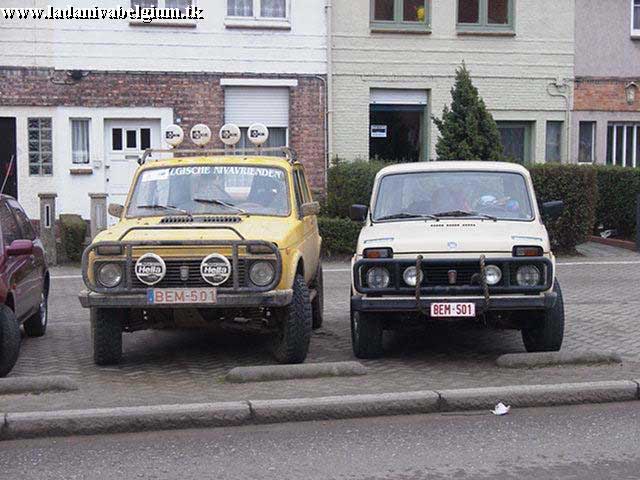
Ladanivabelgium Lifted vs Un-lifted
Much like the Hoodoo2 kit, front and rear rings, but with the inner locator ring cast into the fronts:
Dbf's (Portugal) 40mm
ring lift
These replace the factory rubber rings that sit above the coil (these particular kits comes with some damper relocation mounts so standard dampers cen be used).
Note that you need to retain the factory steel ring that sits between rubber and the coil (not all kits come with this ring).
These appeared on Ebay being sold by sstyresandwheels09. I know nothing about the vendor or the kit, but looks pretty good and seems reasonably priced. Rings are 25mm front and rear and ball-joint spacers are 10mm. Custom sizes may be available.
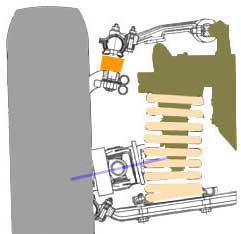 Coil Lifts
Coil Lifts Coils are an easy and usually legal way to lift a Niva. Coils can be either longer or stiffer (or both) to raise height. Some people do not like the stiffer suspension caused by stiffer coils, and stiffer coils are generally a disadvantage for articulation off-road.
Coil lifts do not raise the coil platform, so they avoid the steering anti-roll bar conflict problem.
Like other lifts, you'll generally need to put longer dampers in the rear, though the front dampers can stay standard if you do not lift more than 50mm.
Coils are best ordered to length
as cutting them down to suit is legally frowned upon in some countries. If you
do cut them down yourself, make sure you know how to do it properly (eg, cut
the tangential end only, don't use heat - good guides here
![]() and here
and here
![]() )
)
Niva
coil lift magazine article
UK magazine, International Off-Roader, did an article
on a Niva coil lift.
I've read various reports of other coils that fit in front and rear without needed to be cut (eg front coils from HQ Holdens, XC Falcons, Saab turbo rears, Mercedes W123 fronts), but so far have found this to be largely unsubstantiated.
Standard Niva coils are 278mm (front), 434mm (rear) - Holden HQ front coils are 380mm and about 1mm thicker and need to be shortened to a free length of around 330mm for the front to give a 50mm lift (Falcon coils need similar treatment); this is what I'm currently running on my own Niva.
As for the rear salada02 from the Australian Niva Forum reports "XE OR XF FALCON REAR VERIABLE RATE COILS FIT THE NIVA AND GIVE A GOOD RIDE".
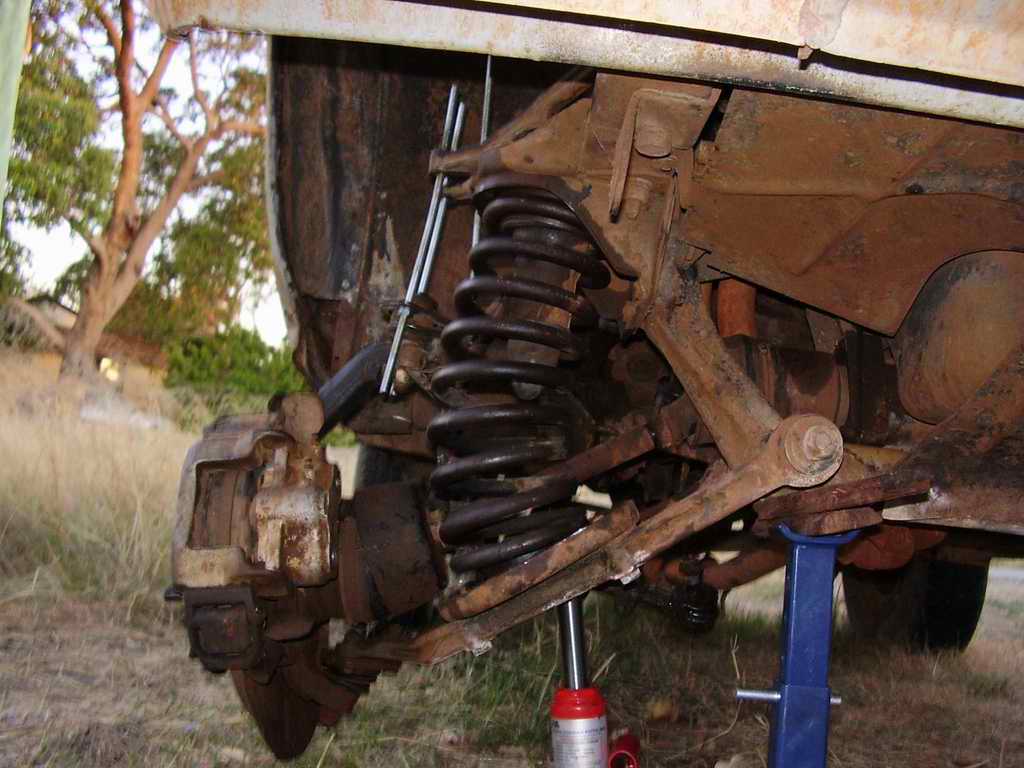
38cm of Holden front coils - no way is that going to bolt up safely
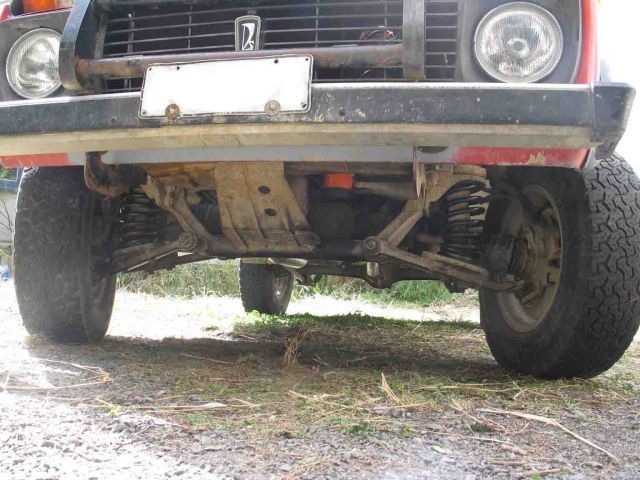
Similar coils from a
Ford Falcon cut to a free length of 33cm give about a 5cm lift; I have Holden
HQ coild modified to 33cm free length in my Niva, which gives about 5cm oof
lift.
Any coil manufacturer should be able to make coils to your specification for not too much more than the off-the-shelf price, but there are also Niva coil lifts available off-the-shelf:
King
Springs ![]() in Australia sell 2" raised coils for Nivas (part no.s: front KLFR10,
rear KLRR11).
in Australia sell 2" raised coils for Nivas (part no.s: front KLFR10,
rear KLRR11).
Cobra
Coils ![]() (sold through Repco) in NZ sell 'raised'
(sold through Repco) in NZ sell 'raised'![]() coils for Nivas
coils for Nivas
Front: Part no: CLFH-01 "Modification to top bump-stop
may be required. Extended length shocks recommended."
Rear: Part no: CLRH-01 "Long travel shocks recommended"
Dobinsons
![]() in
Australia (will export) sell a 35mm coil lift (front C33-02, rear C33-03).
They also sell extended dampers for this kit, the front ones are heavy duty
and require the coil mount to be reinforced (front GS33-087B, rear GS33-635W).
in
Australia (will export) sell a 35mm coil lift (front C33-02, rear C33-03).
They also sell extended dampers for this kit, the front ones are heavy duty
and require the coil mount to be reinforced (front GS33-087B, rear GS33-635W).
A complete kit of 35mm Dobinsons with "Robust" brand gas shocks is
sold by on EBay by ultracheapauto
![]() from Australia.
from Australia.
Pedders![]() ,
Opposite Lock, Iron
Man
,
Opposite Lock, Iron
Man ![]() ,
Lovells and Old Man Emu also have listed
up-rated coils for Nivas. You may also need longer dampers in the rear.
,
Lovells and Old Man Emu also have listed
up-rated coils for Nivas. You may also need longer dampers in the rear.
Scorpion
Racing (UK) used to do raised Niva coils that came with
a ball-joint spacer: "They have a 15% stiffer spring
rate and give 2 inches (5 cm) of lift. Essentially, the new springs have 2 more
full coils over the stock ones. The front coils are wound from 16mm (5/8 inch)
diameter steel and have an overall height of 29 cm. The new coils have 8 full
turns plus a little overlap. The free height of the new coils is 29 cm (stock
free height is 27.8cm). The rear coils are wound from 14.6mm (9/16 inch) diameter
steel and have an overall height of 46cm (stock free height is 43.4 cm). The
new rear coils have 11 turns plus about 1/4 turn overlap."
However,
many people have found the Scorpion coils to be too stiff for off-roading.
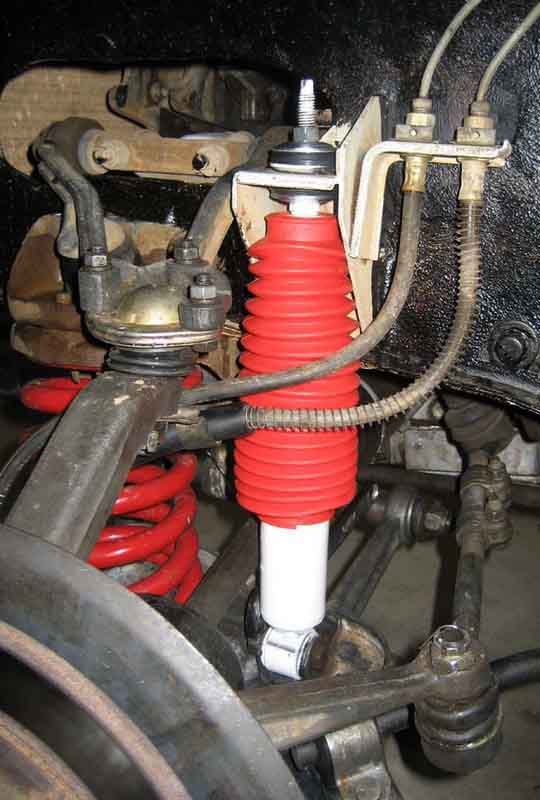
King Springs and Rancho RS5000
2" lift
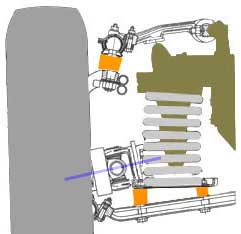 Tube Lifts
Tube Lifts Tubes work on the same principle as the Hoodoo wedge kit (hence the same warnings apply see "Important note" above), but uses tubes instead of the wedges to raise the coil platform. Tube front lifts are popular in Russia and South America, and are available off-the-shelf.
Size
Length It's also usual for the tubes on the outer end of the wishbone to be longer than the inners (thus leveling the coil platform the same way a wedge does). Hoodoo advises against his wedge being any higher than 25mm (outer end), so likewise 25mm would be the tube length for a 50mm lift.
Steering-arm problem: From what I can make out on the Russian forums a maximum tube length length of less than 20mm for the outer mounts seems likely to avoid the steering-arm problem, but 25mm high outers will certainly catch (if you keep your anti-roll bar); though "Engineer" on the Russian Niva FAQ used 2x20mm, 2x17.8mm, 2x13.2mm, & 2x10.7mm and still found the anti-roll bar mounts needed shifting. See warning below (and bare in mind that there are differences between lhd and rhd steering set-up so this may or may not apply).
Diameter As for the tube diameter I'd make it at least the same as the seating area on the wishbones to make sure you're not putting too greater stress on a smaller area of the coil-platform. "Engineer" on the Russian Niva FAQ suggests an outer tube diameter of 30mm, and inner of 10.5mm.
Dalibor's
DIY Niva tube lift
From Croatia, Dalibor's tube lift (image below) gives the dimensions
of his tubes as: 1x25mm, 2x12.5mm, and 1x7.5mm per side. Instructions
for Dalibor's Tube Lift.
Ahorton's
DIY Niva tube lift
Ahorton from Difflock has done a budget DIY version (images below)
that gives a 2 inch lift using 8 short brass tubes: garden water fittings
with a wall thickness of 2.5mm, ID of 12.5mm (and no b-j spacer afaia).
4 tubes on each side, with lengths 2x25mm, 1x17mm, and 1x5mm per side. I'd
think that these would need to be thicker walled so their seating area is at
least the same size as standard (ie these have a smaller area of the coil's
base-platform taking the same total loading), but after 18 months of use
Ahorton reported them to be in fine condition with no issues.
A French version uses 10 and 15mm long steel tubes, I expect this would give about a 3cm lift. I'm not sure why their centre holes on the black set are so much bigger than the bolts, I'd certainly be making it as snug fit to the bolts as possible to stop movement. Also I'd make the tubes' outside diameter bigger than the silver set below because the smaller seating area than original on the base-plate will put more focused forces on it:
Washer
'tube' lifts
I'd be a little dubious of a big stack of washers instead of tubes - and
the WOF/MOT inspector would laugh them out of the workshop - though the
Brazilian Scherer lift kit (left) uses 10 washers on the outer bolt,
and 5 on the inner (plus a ball-joint-spacer, and rings on the rear). Personally
I'd only use anything more than a couple of washers only to trial various heights,
and then have steel tube made to fit after you've determined the correct heights
for your specific application and your Niva.
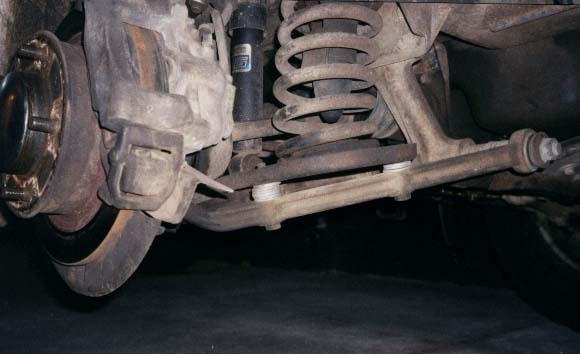
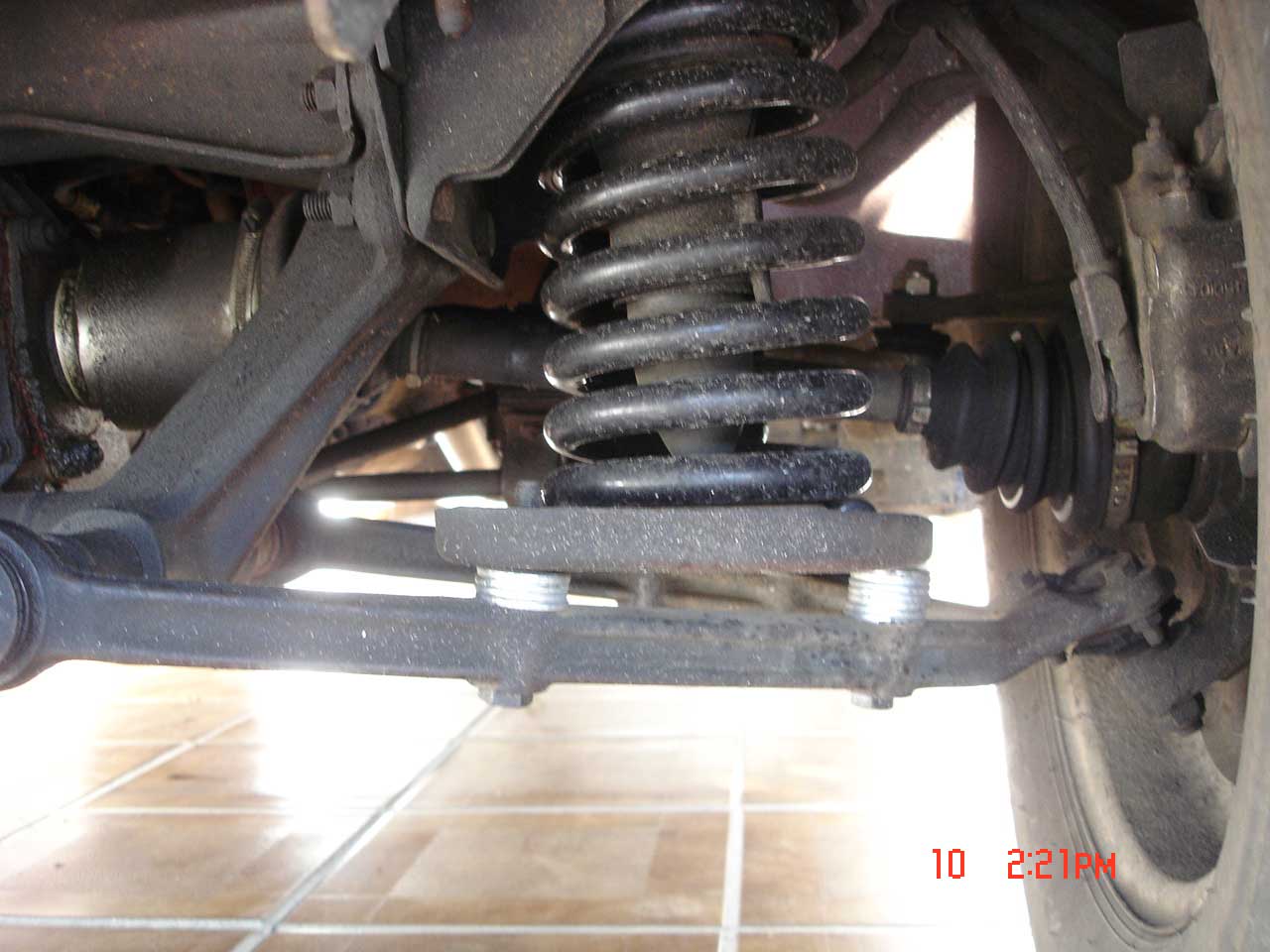
Scherer and another
Brazilian lift recommend stacks of 10 (outer) and 5 (inner) washers (click
on image for a bigger view). if not taller than 20mm should avoid the steering
problem...
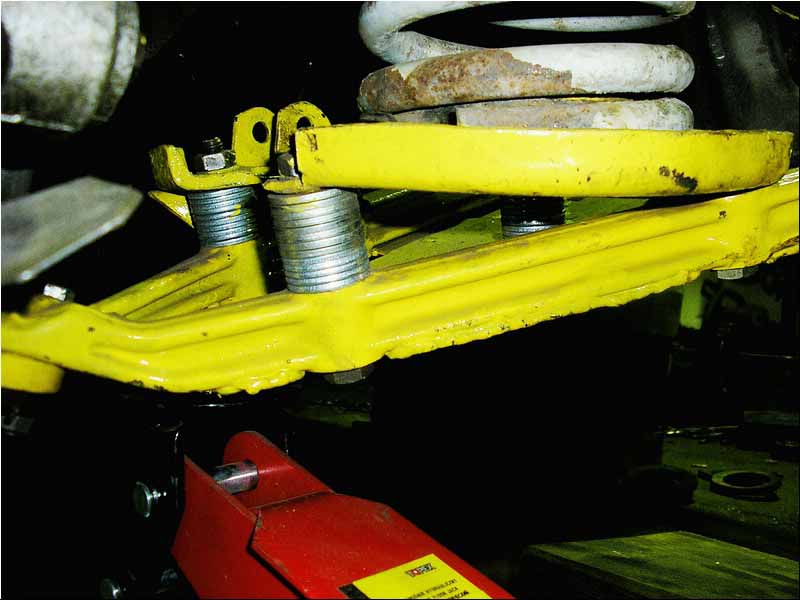

...but if the tallest stack is more than 20mm, be
aware of the steering interference problem (see below).
This has recently appeared on Ebay being sold by sstyresandwheels09. I know nothing about the vendor or the kit, but looks ok and seems reasonably priced. Tubes are 2@25MM 4@12.5mm 2@7.5mm giving a 50mm lift and a 20mm thick ball-joint spacer. This kit also comes with 2 rear lift rings (20mm). Custom sizes are able to be made.
Brazilian versions
can be bought from Apoio
4x4 ![]() or Natal 4x4
or Natal 4x4
![]() (who also sell
other Niva accessories). These kits look to use a plastic compound tubes
instead of steel; if you copy this make sure you use impact and shatter resistant
plastic compound so they do not collapse or deform.
(who also sell
other Niva accessories). These kits look to use a plastic compound tubes
instead of steel; if you copy this make sure you use impact and shatter resistant
plastic compound so they do not collapse or deform.
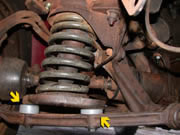
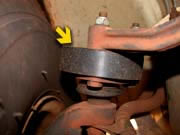

Apoio 4x4 (click
on image for a bigger view)
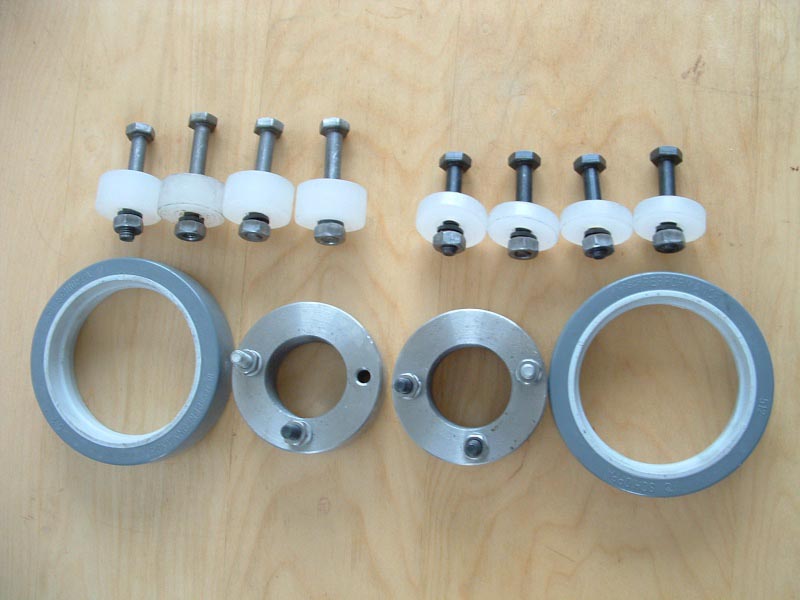
Natal 4x4
There are several
Russian tube lift kits available (generally with rings in the rear). The kit
below is includes lengthened top diff arms and panhard to account for altered
geometry of the the rear lift, rear damper spacers, ball-joint-spacers, and what looks
like a modified coil-platform (I assume to avoid the steering-arm problem).
I believe this kit can be bought off-the-shelf from Kor
Off Ka 4x4 ![]() .
.
Available
with either damper relocating brackets:
Or with longer dampers (and some
reinforced lower rear arms):
A similar kit with lengthened rods etc can be bought from F-Design (who also sell other off-road Niva accessories).
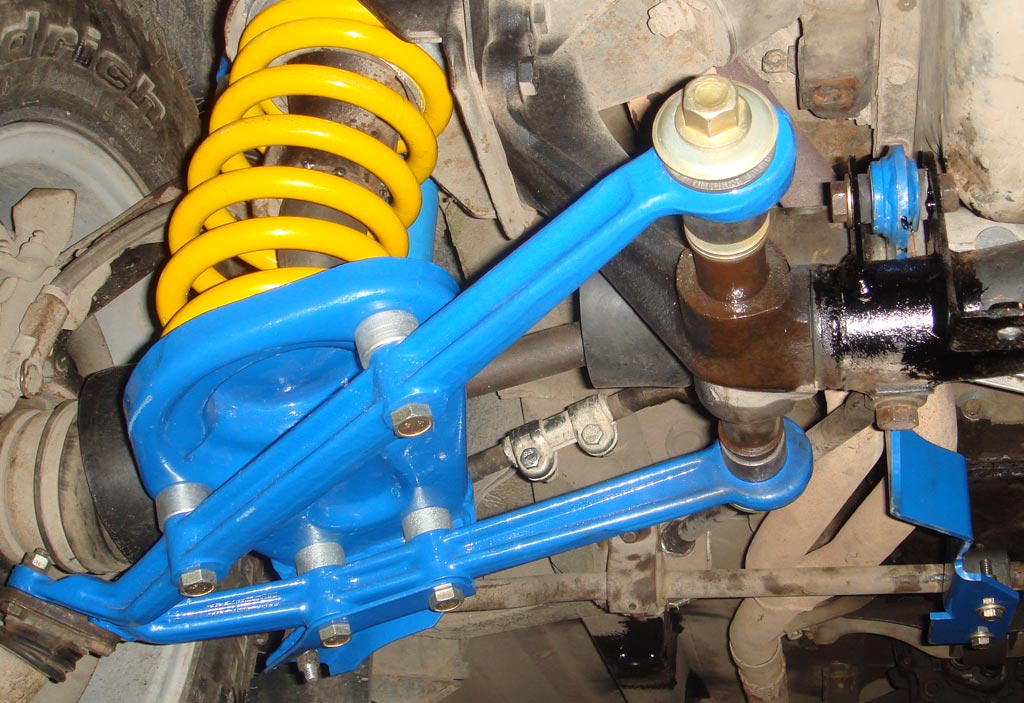
Russian F-Design front tube lift
NivaShop probably also sell kits and lift parts, but as their website refuses to load on my PC in any browser on my computer, I can't tell you anything about them - ask about on forums; people have dealt with them.
Most Niva rear-end lifts are done with either spacer-rings or longer coils, and generally require longer travel dampers to be fitted.
Hoodoo's rear spacer ring is made from polybush or similar shatter-proof material: Internal diameter 86mm, Outer diameter 136mm, Wall width 25mm, Wall height 25mm. Longer rear dampers are needed: 22"/560mm (fully extended).
Do-It-Yourself versions have been made from diverse handy materials including: Ikea chopping boards, wood, hard rubber, and even wheel-barrow wheels.
If you want metal rings, steel or alloy etc can be used but the inner diameter will need to be slightly larger as the above dimensions are designed to stretch over the cone, and some slight shaping of the outside as the hole it sits in isn't fully square. See above under Ebay Ring Lift for an off shelf alloy set.
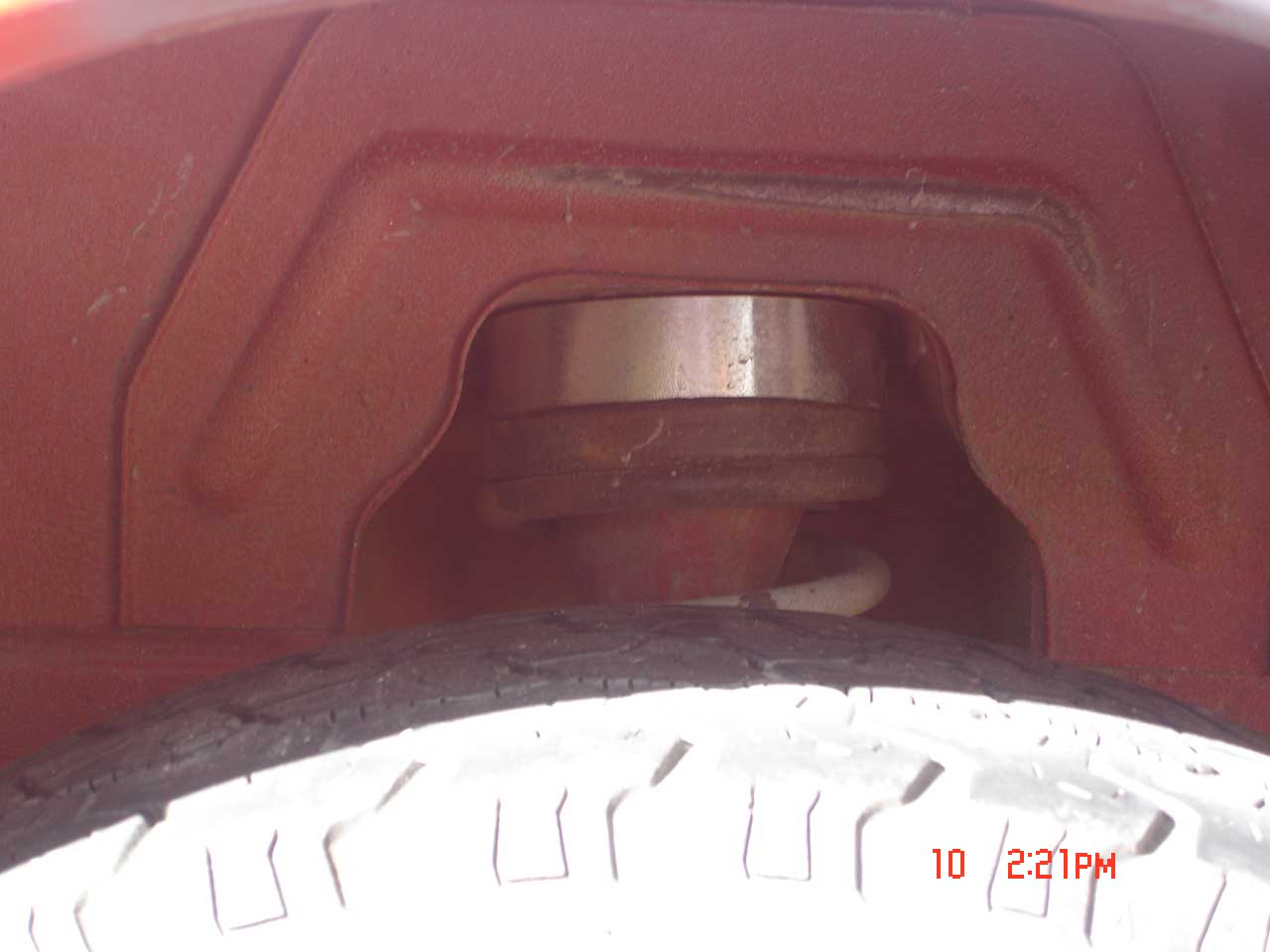

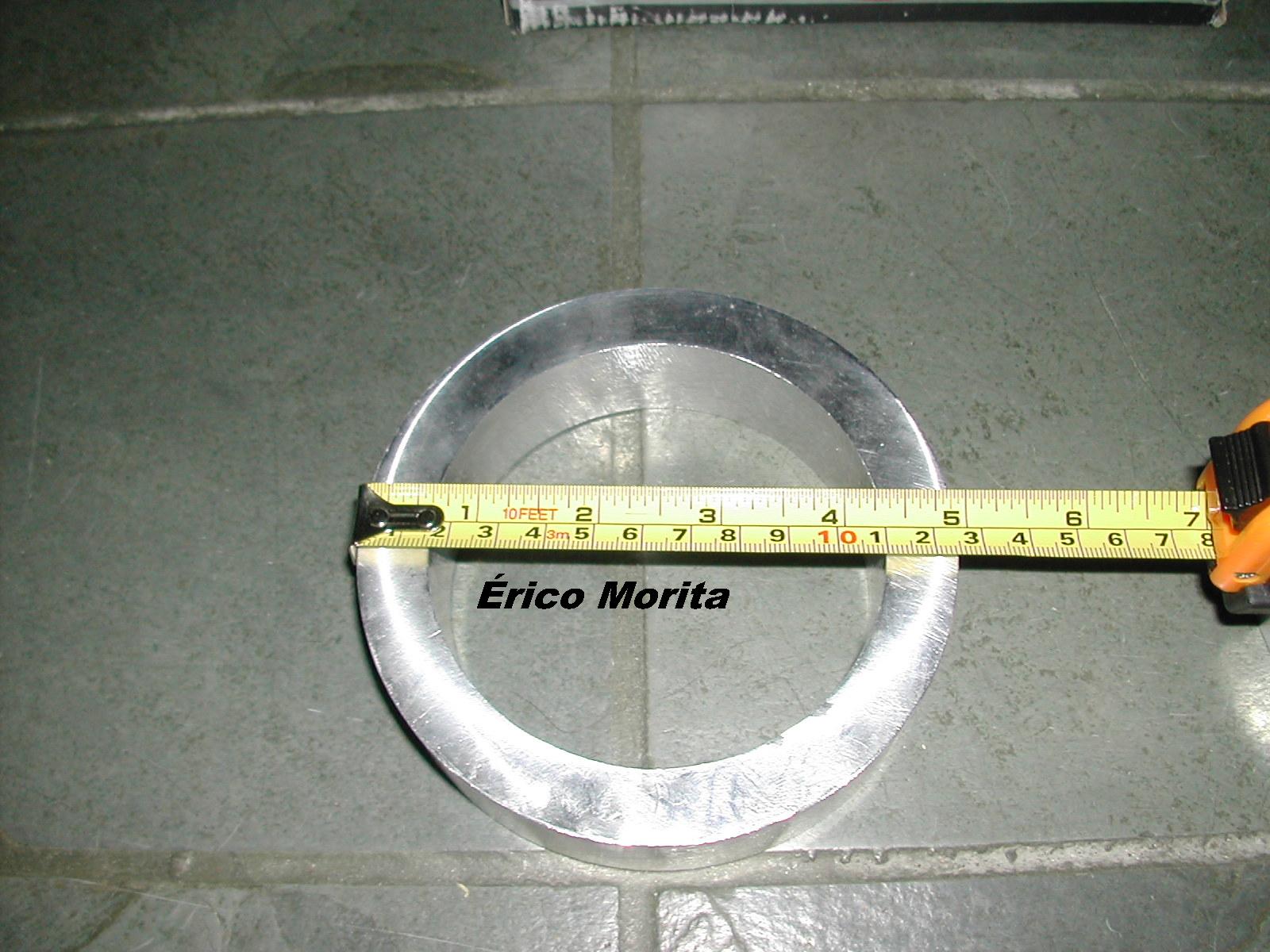

Alloy rear ring with
measurements (click on image for a bigger view).

Metal ring with coil
locators; ie replaces the entire Lada top ring instead of sitting on top of
the Lada ring like a Hoodoo rear
If you can not find longer coils or suitable material to make Hoodoo style rear rings, you can raise the rear coil platform to achieve much the same effect.
After lifting the rear you may also need to adjust your brake proportioning valve, as the lift affects the relationship between the brake-regulator's control rod and the body (which determines the brake regulator's behaviour and can be dangerous if not correct).
If
you can't get enough adjustment to achieve this, you can extend the linkage
between the control rod and the axel casing to restore the relationship between
the control rod and the floor:
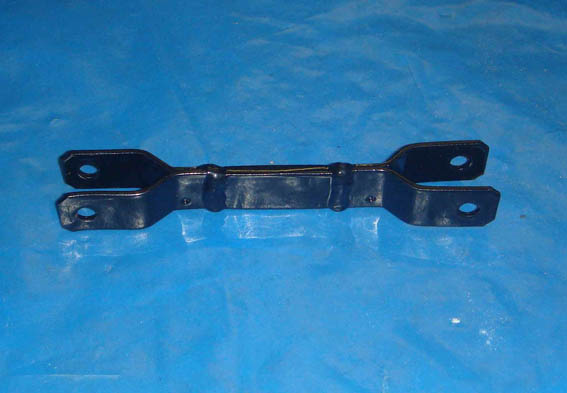
Extended brake proportioning valve lever (available from
F-Design and several other Russian lift suppliers).
The length is this extension is a matter of debate (and probably depends on the weight of your Niva and how saggy its coils are), for 50mm lifts (ie using 25mm spacers) extending the link by 25mm to 37mm has been reported to work.
Brake Hose: The standard brake hose is fine for 50mm lifts that retain the the standard dampers in the standard location, but with lengthened dampers (or relocated standard dampers) the brake hose will very likely be streched to its limit when the axle is at full droop, so will need to be replaced with a longer hose.

Brake hose (at full suspension droop) with 50mm Hoodoo rear lift and longer
dampers; this is not safe and needs to be replaced
with a longer hose.
Here's the parts I that were used to make my extended rear brake hose:
Front: Dampers (a.k.a. shock-absorbers) remain stock length with a 50mm Niva lift, and standard Niva dampers are perfectly up to off roading, many find them better than up-rated after-market dampers (Rancho RS 5605 is a standard replacement size if beefier shocks are needed).
Rear: With small lifts standard length dampers are fine (eg dragonlada has run 3 inches longer springs (30mm lift) at the rear with original length shocks for 10 years). But for a 50mm lifts longer rear dampers of 22"/560mm (fully extended) are recommended.
Explorer Pro Comp ES3000 (oil) or ES9000 (gas) dampers are popular on many lifted Nivas (Hoodoo prefers the smoothness and more gentle absorption of the 9000s over the 3000s). Dampers from some Nissan and Toyotas 4WDs and Mitsubishi cars are also the correct size (eg Nissan King Cab D21 shocks are the same compressed length as the Lada and 40mm longer on extension). Rancho RS 5118 are the right length for a 50mm lift (standard length is RS 5113), but will likely be stiffer than standard.
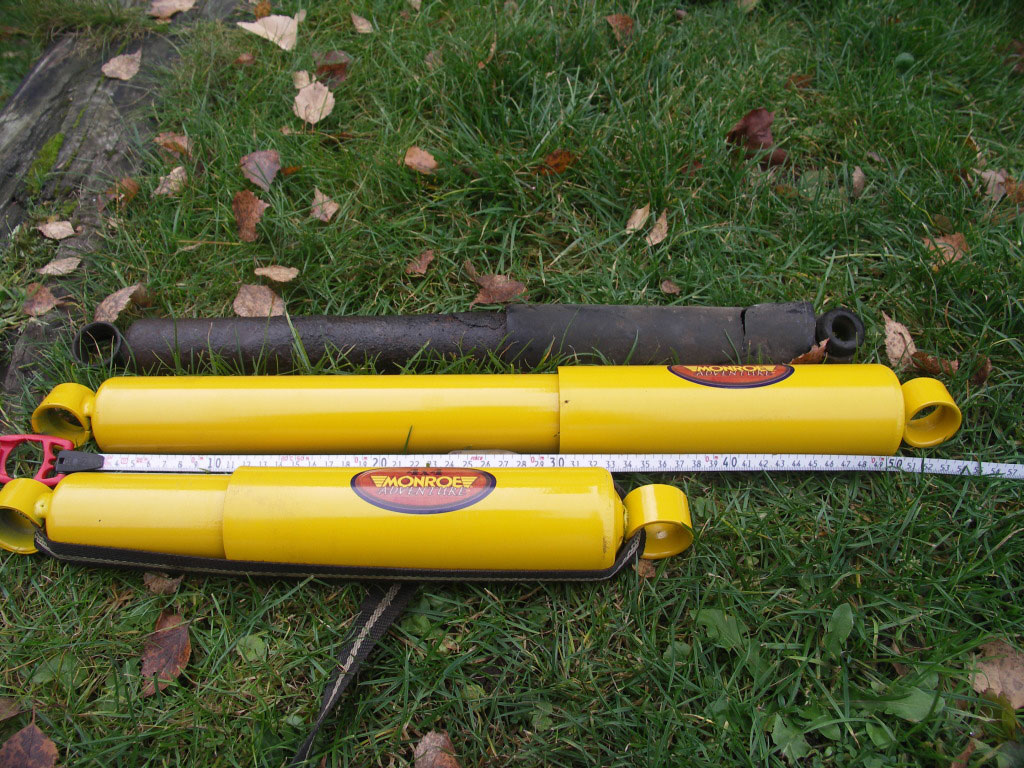
Nissan King Cab D21 rears vs Niva rears; note tube body on the Munroes is wider
than Lada's so may need spaced away from the axle a little (or find a make with
narrower tubes).

If you use too long shock-absorbers the coils will become uncaptive when the
suspension articulates.
Note: with stiffer than factory dampers (eg hi-performance oil & most gas types) the mounts will likely need to reinforced, especially the front tops. Plus you will loose some off-road performance with overly stiff shocks.
Alternately, instead of longer dampers to accomodate rear lift, the lower damper mounts can be raised so standard length dampers can be used (or instead the upper mounts counld potentially be moved outboard to allow greater effective drop for the original rear dampers).
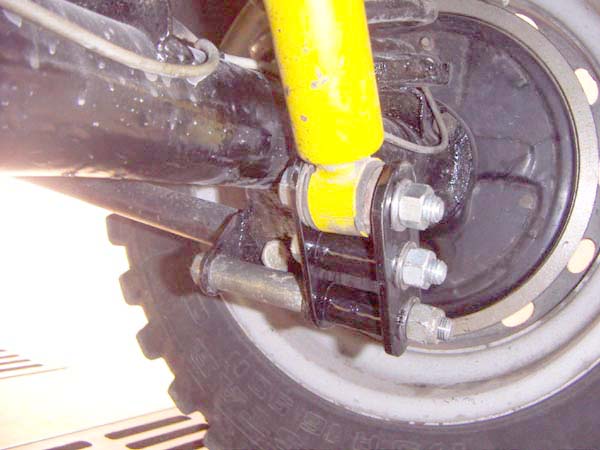
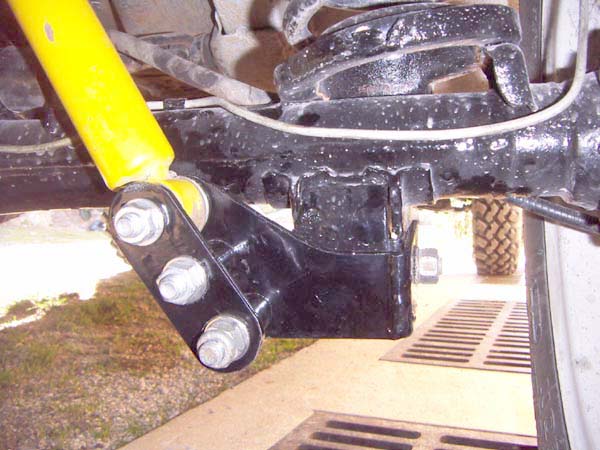
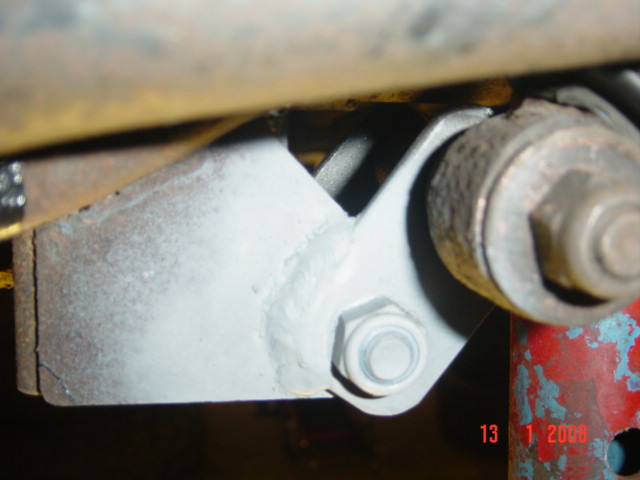
But I think this might mean loosing 2" of upwards travel
useful for articulation, that could be otherwise gained by fitting dampers with
the sock compressed length and 2" longer travel.
A ball-joint spacer serves two purposes. It increases the gap between the suspension and the bump-stop (which is lost when you lift your Niva), and it changes the camber setting range of the tyre (which is changed when you lift your Niva).
A ball-joint spacer is not essential for for smaller lifts, but you will loose some suspension travel (lifting effectively pushes the bump-stop upwards towards the upper suspension, thus losing some travel). This can be addressed by either trimming some of the rubber off the top bump-stops, or by using a ball-joint spacer.
A ball-joint spacer (fitted between the top ball-joint and the top suspension arm) will not only save you having to trim your bump-stops, but it may also help keep your camber within the original alignment range, especially with bigger lifts.
The thickness of the spacer depends on your application: I have a 20mm thick ball-joint spacer which brings things within range for my 50mm lift. Others have used spacers between 10 and 30mm thick (the more the lift, the more you'll likely need), though generally between 20 and 25mm is fine for 50mm lifts, any more and you may have too much positive camber.
Always use high-tensile steel bolts (eg rated 8.8 or better) capable of taking the forces in suspension when adding spacers (the factory bolts are too short), and use lock-washers or nylock nuts.
Remember lifting also lifts the centre of gravity, making you more likely to roll when on a tilt. The more you lift, the more you decrease the vehicle's angle safe operational angle.

Lifting decreases your tilt angle limit
It is generally accepted that a 50mm front lift puts the CV angle near their effective operational limit. And with my 50mm lift the inner track-rods (ie where the Pitman arms join to the steering rods) are on a greater angle than ideal, sitting very near the limit of their movement in one direction when the suspension is at full droop.
More lift is possible, and some people have done 75/80mm lifts and had no CV problems, but others have not been so lucky. With such bigger lifts you'll probably need to cut more off the bump-stop, you also may need longer shocks and brake hoses, and I'd consider bending the ends of the Pitman arms so the inner track-rod angle is more normalised.
If you need more than 50mm lift in the front body lifts (eg Simon's | Spanish) can be done to avoid the CV and track-rod problem, but a body lift won't get you any meaningful extra ground clearance (ie the diff is not raised any higher from the ground), so all you achieve is a greater approach angle (at the cost of making you far more likely to roll off-road due to the increased centre of gravity).
The rear of the Niva will happily accommodate a 50mm lift (ie 25mm thick Hoodoo rings). It will bring the rear wheels and axle forward and to the the right a little because of the suspension arms, but everything should remain within an acceptable range.
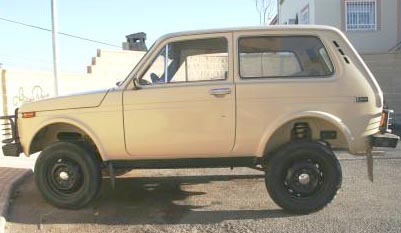
The more you lift the rear the more the radius arms pull
the rear wheels forward; hence longer arms are needed for bigger lifts (though
note on articulation the wheels will still move backwards in the arch as they
are pushed upwards - I presume this is best corrected by chagning the ration
of the top to bottom arms to suit).
The angle that drive-shaft's universal joints run at also need to be considered, as lifting will increase this angle. No problems have been noted with 50mm lifts, but if this is a problem with higher lifts a double cardan prop shaft can be used to help solve this (or re-angling the differential's face, see below).
The sideways relocation of the axle caused by a lift isn't grenerally a problem with a 50mm lift. But for bigger lifts it can be corrected by an adjustable or lengthened panhard-rod (see picture above of the Russian kit), or lowering the panhard's body mount so it sits at it's standard angle in relation to the axle.
The rear axle can be relocated rearwards slightly by slotting the holes in the mounting bracket where the lower rear arm bolts to the body; ie simply relocating the bracket a few mm rearwards (though this may turn the face of diff downwards a little adding to the angle the universal-joints have to work through). Sadly the upper arm mounts are welded on so can not be as easily relocated.
If a larger rearwards relocation of the axle is needed you can replace the upper and/or lower arms with adjustable or lengthened arms (which are now commonly available, and a great way of correcting the changes to geometry caused by lifting - indeed they are a good idea even with a 50mm lift). You may be able to find something from a wreckers yard that has adjustable arms of the correct range and mounting sizes.


F-Design modified rear longitudinal bars
Bear in mind that altering the effective length of only the upper or only the lower arms will change the angle of the diff face, and thus the angle the universal joints run at. This could obviously be used to advantage by tilting the face slightly upwards to help relieve the universal-joint's increased angle caused by lifting.
The rear can probably be lifted a little more without as many issues as the front, though those that have lifted the rear around 80mm generally find adjustable or lengthened suspension arms are needed to get things right. Massive lifts (eg 150mm) will likely require a total redesign of the rear arms (eg no panhard and/or 3-link or 4-link top arms), and drive-shaft joins.
The brake hose will need to be swapped for a longer one for 50mm (or greater) lifts than use longer than standard dampers (see above).
My current lift consists of genuine Hoodoo rings in the rear with longer dampers, the front has longer & stiffer coils with ball-joint spacers.
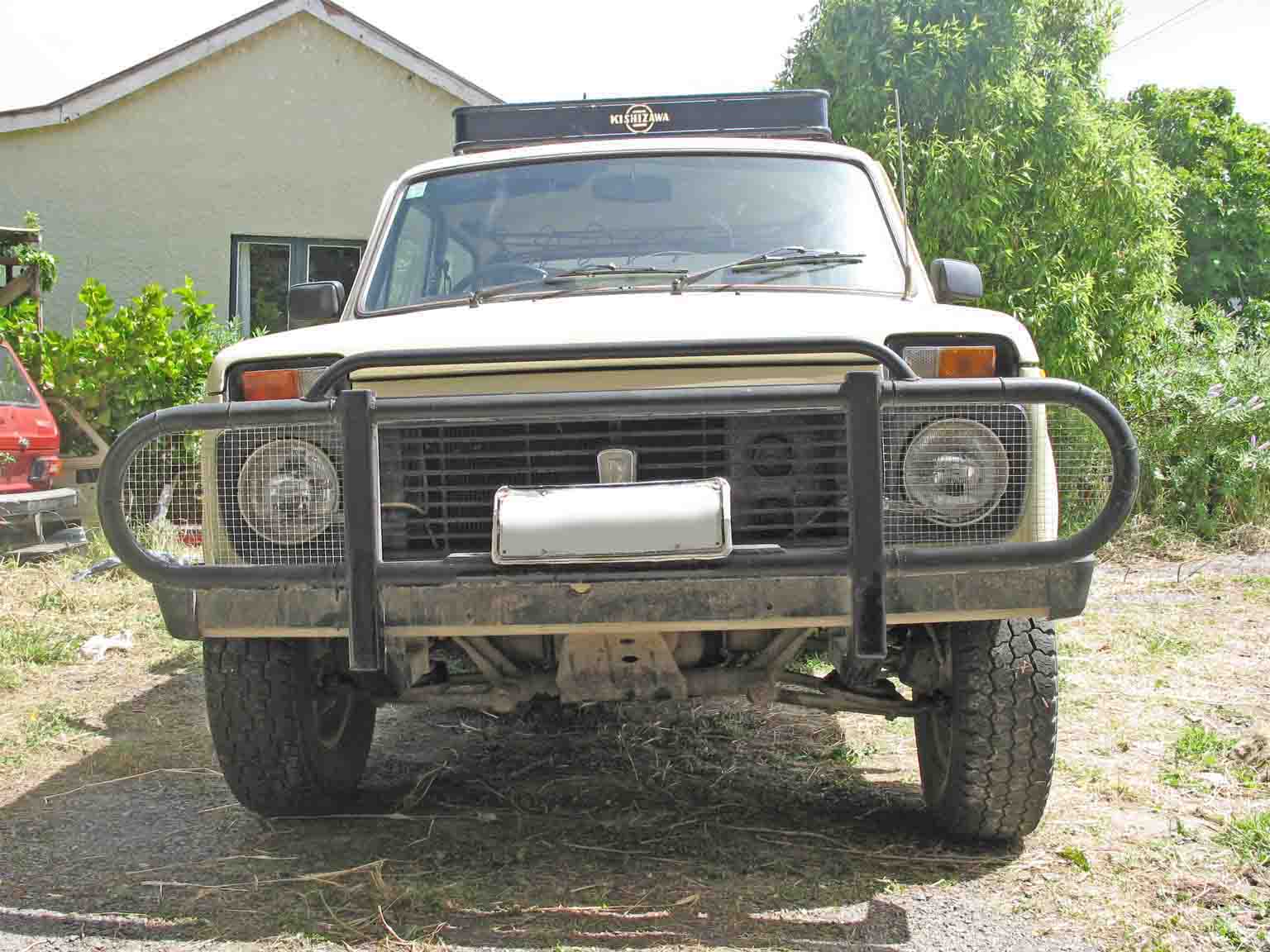
Un-lifted vs Lifted (on a Hoodoo2
instal we helped prototype)
Currently I have some modified Holden HQ coils in the front - they were supplied 38cm long (compared to the Niva's 28cm) and about 1mm thicker wire so were altered to 33cm free length. I have only changed to this lift because it's more legal than the prototype Hoodoo2 lift I had previously (we have unusually strict - and often pointlessly strict - car modification laws in New Zealand). It's slightly taller than prototype Hoodoo2 and around the same as the original Hoodoo; ie around 50mm. And the anti-roll bar has been removed to help increase articulation.
Several people who have tried after-market longer/stiffer springs have found them to be too hard for comfort (notably these coils were mostly the UK Scorpion ones people found too stiff). Mine are probably a little stiffer than ideal, but certainly tolerable to me, especially without the anti-rollbar - though I generally personally prefer a stiffer feel (ew, er) on the road. This stiffer coils may slightly degrade off-road performance as they potentially decrease articulation a little, but I'm yet to compare and see if this is the case.
I have 20mm thick ball-joint spacers to help gain distance between the bump stop and the top arm, and to get back within camber adjustment range.
I have Hoodoo rear rings with shock-absorbers for a lifted Nissan Navara (which are just slightly too long as the top of coil slightly becomes unseated after any serious articulation).
This lift has worked and it has the off-road clearance of some larger wheeled 4x4s; I've traveled many deeply rutted tracks that would have caused issues when un-lifted. However, there are several problems that still need addressing for it to be perfect:
WARNING 1: Modifying your suspension (even including anti-rollbar removal) may be illegal or subject to special tests in your country, so check first. It may also affect your insurance cover, so check this also.
WARNING 2: Always use bolts rated for the job, if you replace suspension or steering bolts use graded replacements (eg 8.8 or better), and lock-washers or nylock type nuts.
WARNING 3: It is generally considered that a 2 inch (50mm) suspension lift puts the angle of the CVs and steering ball-joints at their effective operational limit. You can lift more, but you'll greatly increase the risk of premature CV and ball-joint failure.
WARNING
4: With any front lift that raises the coil-platform (ie wedges,
plates, tubes, or washers) make sure the steering arms may touch the anti-rollbar
- which could suddenly lock your steering on full lock. You can either remove
the anti-rollbar, or do Hoodoo's solution above (essentially relocating the
bar's mounts on the underside of the coil platform and grinding some off the
coil-platform if necessary).
Please read the
Disclaimers near the bottom of this page.
I can not vouch for the trustworthiness
of all of this info. While
the info posted is from mostly reasonably reliable or reliable looking
sources, I have not tested much of it myself (indeed if you see
something here that is misleading - or plain wrong - please e-mail me).
I take no responsibility if you do something suggested
on this site and ruin your car or hurt yourself (however, if this does happen
then please do tell me so I can update things). Beware that mechanical
work, 4x4-ing, and life in general can be dangerous. The information in this
website does not hold its authors or hosts liable for any damage or injuries
sustained.
Collection of various lifts in my Niva Gallery
Sump & diff-guards, and other armour
| Home | Newbies Guide | Cloggy's DOHC | Lada Niva Clubs | Niva Lift Kits | Gallery | Links |
This page lives at the www.ladaniva.co.uk/baxter domain, if you’re reading it from anywhere else you may not be reading the most up-to-date copy.